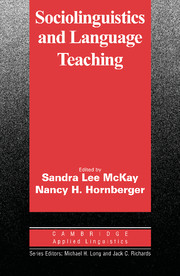Book contents
- Frontmatter
- Contents
- List of contributors
- Series editors' preface
- Preface
- Acknowledgements
- Part I LANGUAGE AND SOCIETY
- Part II LANGUAGE AND VARIATION
- Part III LANGUAGE AND INTERACTION
- 8 Ethnographic microanalysis
- 9 Interactional sociolinguistics
- 10 Intercultural communication
- Part IV LANGUAGE AND CULTURE
- CONCLUSION
- Index
8 - Ethnographic microanalysis
Published online by Cambridge University Press: 22 July 2009
- Frontmatter
- Contents
- List of contributors
- Series editors' preface
- Preface
- Acknowledgements
- Part I LANGUAGE AND SOCIETY
- Part II LANGUAGE AND VARIATION
- Part III LANGUAGE AND INTERACTION
- 8 Ethnographic microanalysis
- 9 Interactional sociolinguistics
- 10 Intercultural communication
- Part IV LANGUAGE AND CULTURE
- CONCLUSION
- Index
Summary
Introduction
The perspective of ethnographic microanalysis
The central concern of ethnographic microanalysis is with the immediate ecology and micropolitics of social relations between persons engaged in situations of face-to-face interaction. Ethnographic microanalysis (which has also been called the microethnography of social interaction) is both a method and a point of view. Using videotapes or films of naturally occurring interaction, the microanalyst looks very closely and repeatedly at what people do in real time as they interact. From this approach to analysis comes a particular perspective on how people use language and other forms of communication in doing the work of daily life.
Two emphases in this perspective are especially important for language teaching. One concerns the situated character of communication in social interaction. Goffman (1964) observed that the social situation is the basic unit or scene in which everyday life takes place. The situation is influenced by the wider world, but in important ways what happens in an ordinary social situation has a life of its own; that is, the situation is a partially bounded social setting. What happens in a given situation may be powerfully influenced by general societal processes – the economy, the labor market, and the class position of participants in the situation; race, ethnic, and gender relations; religious identification and beliefs; broad patterns of language and culture in the society at large. But these factors do not totally determine what happens when particular people interact in a social situation.
- Type
- Chapter
- Information
- Sociolinguistics and Language Teaching , pp. 283 - 306Publisher: Cambridge University PressPrint publication year: 1995
- 18
- Cited by

